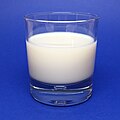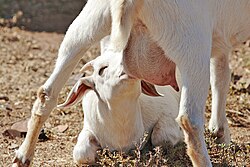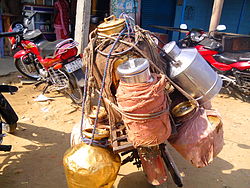Milk
Milk is a white liquid made by mammals, like cows, dogs, and humans. It is made in the mammary glands (breasts, udders, or teats) of female mammals. Newborn babies must be given milk before they can eat solid food. Milk has many nutrients to help babies grow and be healthy. It is also a rich source of calcium which is good for their bones and teeth.
Storing milk
If milk is not kept cold in a refrigerator, it will become sour after some time. When milk is warmed, it turns sour.[1] Fermentation makes this happen. Lactic acid bacteria change the milk sugar into lactic acid. Fermentation is used when making dairy products.
Milk is often pasteurised before humans drink it. It is made into dairy products like cream, butter, yogurt, ice cream, or cheese. Pasteurised cows' milk will turn sour if it is not kept in a refrigerator. Milk should be stored between 1° and 4° Celsius. If milk is treated with very high temperatures, it will last longer before spoiling. This means it does not have to be put in the refrigerator until it is opened.
Goat milk
Goat's milk is the milk from a goat. It can be drunk, both by humans or baby goats, or cheese can be made from it. This cheese is called goat's milk cheese.[2]
Coconut milk
Coconut milk is not real milk because it comes from a plant instead of an animal. However, it looks similar to real milk because it is white. It also does not have as many nutrients as real milk. It is made by removing the white "meat" from a coconut, pressing or squeezing the "meat", then adding water. It is sometimes used in cooking, for example, in Thai curry. Coconut cream is a thicker version of coconut milk which contains added sugar.
Almond milk
Almond milk is produced by grinding almonds and processing that liquid for drinking.
Cow milk
Cow milk is the milk from a cow. Whole cow’s milk contains about 87% water.[3] The remaining 13% contains protein, fat, carbohydrates, vitamins, and minerals.
Nutrients
Milk forms an important part of a person's daily balanced diet. It contains a lot of calcium that helps bones and teeth to grow stronger. Also, milk provides the body with high quality proteins, and helps in meeting the body's requirement for vitamins. One glass of milk gives about 44% to the recommended daily vitamins intake. Some kind of milks, though, do not have good calcium. These kind of milk products include cream, cottage cheese, ricotta cheese, and cream cheese.[4]
Lactose
Milk contains a chemical called lactose. Babies make an enzyme called lactase inside their bodies. Adults make less lactase. If they do not have enough, they may not be able to digest lactose anymore. This problem is called lactose intolerance and it affects many adults. There are many medicines that help adults digest lactose. Many lactose-intolerant people drink soy milk instead of animal milk, because it does not contain lactose. Soy milk tastes similar to animal milk, but it is chemically very different and is made from soybeans.
Ability to drink milk
Most mammals shut off the ability to digest milk early in life. Then they turn to a diet without milk. Humans were like that originally. We don't know all the details, but it seems what happened was this. They learnt that at least some milk from cattle was good for humans. They bred the cattle until the cattle produced milk regularly, not just for their young.
The few people who could digest milk gradually increased in number. They had the advantage of a ready supply of food (milk).
At that point, it was an advantage for humans to have a regular supply of milk, which they could now digest. So began a process which eventually swept up all humans except a very few. We now think it is natural to drink milk throughout life ("lactose tolerance"), but we are one of the few species which does so.[5] In some human populations, though, lactase persistence has quite recently evolved.[6]
Milk Media
Cows in a rotary milking parlor
The Holstein Friesian cow is the dominant breed in industrialized dairy farms today.
Preserved Express Dairies three-axle milk tank wagon at the Didcot Railway Centre, based on an SR chassis
Milk transportation in Salem, Tamil Nadu
References
- ↑ "Sour Milk Recipes". imqh.com. Archived from the original on 27 March 2010. Retrieved 29 April 2010.
- ↑ "CBM - Fresh goat milk - fresh goat milk from CBM". goat-milk-powder.com. Archived from the original on 24 April 2010. Retrieved 29 April 2010.
- ↑ "Cow milk colostrum: Ingredients and nutrition facts". Archived from the original on 2023-03-29. Retrieved 2023-04-17.
- ↑ "Milk - facts and fallacies - Better Health Channel". betterhealth.vic.gov.au. Archived from the original on 25 December 2018. Retrieved 29 April 2010.
- ↑ Swallow, Dallas M. (December 2003). "Genetics of Lactase Persistence and Lactose Intolerance". Annual Review of Genetics. 37 (1): 197–219. doi:10.1146/annurev.genet.37.110801.143820. ISSN 0066-4197. PMID 14616060.
- ↑ Bersaglieri, Todd; Sabeti, Pardis C.; Patterson, Nick; Vanderploeg, Trisha; Schaffner, Steve F.; Drake, Jared A.; Rhodes, Matthew; Reich, David E.; Hirschhorn, Joel N. (June 2004). "Genetic signatures of strong recent positive selection at the lactase gene". The American Journal of Human Genetics. 74 (6): 1111–1120. doi:10.1086/421051. PMC 1182075. PMID 15114531.
+{{{1}}}−{{{2}}}












